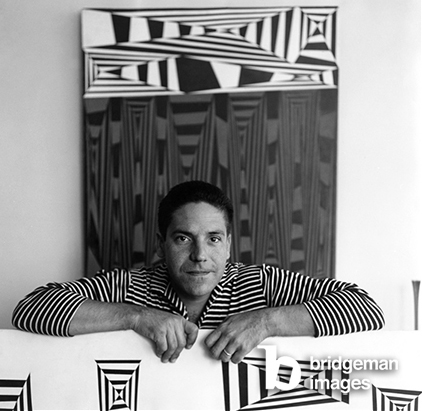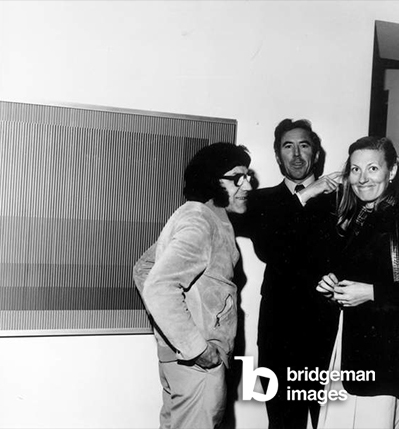Published 08/08/2022
Carlos Cruz-Diez spent his life as a passionate painter. A major protagonist in the field of Kinetic and Optical Art, a movement that encourages 'an awareness of the instability of reality'. Born in Caracas, Venezuela in 1923, as a boy Diez loved drawing in class, playing at his father’s desk with his rubber stamp and observing the world around him.
%20_%20Atelier%20Cruz-Diez%2C%20Paris%2C%20France%20_%20%C2%A9%20Courtesy%20of%20Atelier%20Cruz-Diez%20Paris%20_%20Bridgeman%20Images%20(1).jpg)
Financing his creative freedom
At age 17 Cruz-Diez decided he wanted to be an artist and enrolled at the School of Fine Art, Caracas. Diez was a keen student, always the first to arrive in the morning. He was enthusiastic towards his studies. In order to finance his schooling, he drew comics. After graduating Diez worked in graphic design and as an illustrator whilst also developing his painting.
%20_%20Atelier%20Cruz-Diez%2C%20Paris%2C%20France%20_%20%C2%A9%20Courtesy%20of%20Atelier%20Cruz-Diez%20Paris%20_%20Bridgeman%20Images%20.jpg)
Cruz Diez was a successful academic painter. As he furthered his art history studies, he became to realise that he was not inventing art. His painting techniques abided to the long established art historical path. He wanted to change his approach and chose to explore the relatively obscure path of colour as his focus.

In 1955, Cruz-Diez started to form his discourse and headed to Europe. He travelled first to El Masnou near Barcelona. He also often travelled to Paris - the intellectual capital of the world at the time. Diez adopted the same mindset as progressive artists from different countries. He was happy to discover that he was thinking in line with those developing further in the artistic field. The group in Paris created a tendency that Victor Vasarely called the kinetic art movement.
%2C%20Paris%2C%20France%2C%20November%203%2C%201962%20(b_w%20photo)%20_%20Centre%20de%20Documentation%2C%20Atelier%20Cruz-Diez%20Paris%2C%20France%20_%20%C2%A9%20Atelier%20Cruz-Diez%2C%20Paris%20_%20Bridgeman%20Images%20(1).jpg)
Cruz-Diez then briefly returned to Caracas, Venezuela thinking he could have more of an impact than in Europe where everything seemed to have already been done. However it was during his first exhibition in 1959 at the Fine Arts Museum of Caracas that he realised it was time to migrate from his country for good. During the 1950s it was difficult for people to accept and understand this new kind of art. In August 1960, Cruz-Diez and his family settled in Paris - the core centre of kinetic art.
%2C%20Cruz-Diez%2C%20Carlos%20(1923-2019)%20_%20Atelier%20Cruz-Diez%2C%20Paris%2C%20France%20_%20%C2%A9%20Courtesy%20of%20Atelier%20Cruz-Diez%20Paris%20_%20Bridgeman%20Images%20.jpg)
Accelerating the Kinetic Art Process...
Whilst Cruz-Diez made a living as a graphic designer, he also experimented further with what he had already identified in Caracas the previous year. In 1961, he took part in 'Bewogen Beweging', the first major exhibition on kinetic art, at the Stedelijk Museum in Amsterdam. His presence on the European stage was established. This exhibition was followed in 1964 by 'Movement 2' at Galerie Denise Rene in Paris and then in 1965 by 'The Responsive Eye' at the Museum of Modern Art in New York.
%2C%20Cruz-Diez%2C%20Carlos%20(1923-2019)%20_%20Centre%20de%20Documentation%20%C2%A9%20Atelier%20Cruz-Diez%2C%20Paris%20_%20Bridgeman%20Images%20.jpg)
Cruz-Diez was soon in demand right across Europe. The Kinetic art group sought involvement from the public. The ability to change something static was a new phenomenon. In 1965, he held his first solo exhibition at the Galerie Kerchache, Paris. Cruz-Diez best managed his increasing working demands by inventing tools to help him investigate each art work.
%2C%20Cruz-Diez%2C%20Carlos%20(1923-2019)%20_%20%C2%A9%20Estate%20of%20Carlos%20Cruz-Diez_%20All%20rights%20reserved%202022%20_%20Bridgeman%20Images%20.jpg)
Researching Colour Theory
The School of Fine Art, Caracas taught Cruz-Diez to be a fine figurative and academic painter.His paintings abided by all the rules of convention and sold in great numbers. Cruz-Diez had always felt the urge to break free from the orthodox education of his masters. His drive to try something different created a new break in the art history discourse.

A methodical approach
After first studying academic painting, Cruz-Diez embarked on a period of intense study. He sought out books that dealt with the major subjects of art history. Much like a scientist, Cruz-Diez consistently used a methodical approach. He was used to identifying new patterns, his research saw him conduct meticulous searches. A number of influences informed Cruz-Diez's thinking, notables the works of the artists, Albers, Vasarely and Velasquez, the works of colour theorists, literary figures like Goethe, scientists like Chevreul and the Impressionism movement.
%2C%20Cruz-Diez%2C%20Carlos%20(1923-2019)%20_%20%C2%A9%20Estate%20of%20Carlos%20Cruz-Diez_%20All%20rights%20reserved%202022%20_%20Bridgeman%20Images%20.jpg)
Colour in space
Colour is mistakenly dismissed as a mere consequence of form. It intrigued him and spurred him on to further study the eye, the way light changes and the perception of colour.
%20_%20%C2%A9%20Estate%20of%20Carlos%20Cruz-Diez_%20All%20rights%20reserved%202022%20_%20Bridgeman%20Images%20.jpg)
Gradually Cruz-Diez developed his artistic dialogue focusing on the concept of colour in space and devoid of form. Lines are efficient way for Cruz-Diez to manipulate the play of colour. Lines create a devoid of symbolism and leave colour without an anecdote. Colour becomes a matter of personal preference, an emotional connection. There is an essence of poetry within Cruz-Diez's work. Viewers are able to connect with the illusion of colour portrayal that he creates.
%20_%20%C2%A9%20Estate%20of%20Carlos%20Cruz-Diez_%20All%20rights%20reserved%202022%20_%20Bridgeman%20Images.jpg)
Technological Advancements.
Cruz-Diez used the latest technology to develop his medium of showcasing colour. He always referred to the same principles and overtime with practice, demonstrated increasingly precise methods. He used his computer as tool for further investigations at the age of 80. Until the end of his life, Cruz-Diez continued his research.
%20_%20%C2%A9%20Estate%20of%20Carlos%20Cruz-Diez_%20All%20rights%20reserved%202022%20_%20Bridgeman%20Images.jpg)
Cruz-Diez - an inventor and innovator! He was always looking for solutions to develop his research on colour. The inventor of new tools and reimagining existing tools for his own colourful purposes. His cutting-edge technology allowed him to create visual things he conceived of in the 1960s but could not represent well at the time.
%20_%20%C2%A9%20Estate%20of%20Carlos%20Cruz-Diez_%20All%20rights%20reserved%202022%20_%20Bridgeman%20Images%20.jpg)
Click here to read our recent interview with the Carlos Cruz Diez foundation.
View all of the images of Carlos Cruz Diez’s work.


